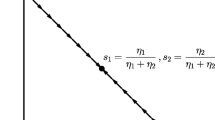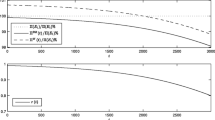Abstract
We analyze the dynamic behaviour of firms that locally interact through price competition in a social environment in an evolutionary game-theoretic model. These firms update their prices according to the behavioural rule ‘Win Cooperate, Lose Defect’ (WCLD), which is often observed in experimental economics. It can be regarded as a generalized Tit-for-Tat strategy. The model can explain the simultaneous emergence of collusive behaviour, price dispersion and occasional local price wars. Price wars only last for a short period of time after which the firms start to collude again.
Similar content being viewed by others
REFERENCES
Axelrod, R. (1987), The Evolution of Cooperation, New York, Basic Books.
Camerer, C.F. (1997), ‘Progress in Behavioral Game Theory’, Journal of Economic Perspectives, 11, pp. 167–188.
Ellison, G. (1993), ‘Learning, Local Interaction, and Coordination’, Econometrica, 61, pp. 1047–1071.
Ellison, G. (2000), ‘Basins of Attraction, Long-run Stochastic Stability, and the Speed of Step-by-Step evolution’, Review of Economic Studies, 67, pp. 17–45.
Ermoliev, Yu., M.A. Keyzer, and V. Norkin (2000), ‘Global Convergence of the Stochastic Tâtonnement Process’, Journal of Mathematical Economics, 34, pp. 173–190.
Eshel, I., E. Sansone, and A. Shaked (1999), ‘The Emergence of Kinship Behavior in Structured Populations of Unrelated Individuals’, International Journal of Game Theory, 28, pp. 447–463.
Freidlin, M. and A. Wentzell (1984), Random Perturbations of Dynamical Systems, New York, Springer Verlag.
Ginsburg, V. and M.A. Keyzer (1997), The Structure of Applied General Equilibrium Models, Cambridge, Massachusetts, MIT Press.
Harn, K. van and P.J. Holewijn (1991), Markov-ketens in diskrete tijd, Utrecht, Epsilon uitgaven, in Dutch.
Kandori, M., G.J. Mailath, and R. Rob (1993), ‘Learning, Mutation and Long-run Equilibria in Games’, Econometrica, 61, pp. 29–56.
Karandikar, R., D. Mookherjee, D. Ray, and F. Vega-Redondo (1998), ‘Evolving Aspirations and Cooperation’, Journal of Economic Theory, 80, pp. 292–331.
Kelley, H.H. and J.W. Thibaut (1978), Interpersonal Relations: A Theory of Interdependence, New York, Wiley.
Laan, G. van der, and A.F. Tieman (1998), ‘Evolutionary Game Theory and the Modelling of Economic Behavior’, De Economist, 146, pp. 59–80.
Lange, P.A.M. van (1997), ‘Persoonsverschillen in coöperatie, individualisme en competitie’, Nederlands Tijdschrift voor de Psychologie, 52, pp. 101–110, in Dutch.
Lange, P.A.M. van, E.M.N. de Bruin, W. Otten, and J.A. Joireman (1997), ‘Development of Prosocial, Individualistic, and Competitive Orientations: Theory and Preliminary Evidence’, Journal of Personality and Social Psychology, 73, pp. 733–746.
Messick, D.M. and W.B.G. Liebrand (1995), ‘Individual Heuristics and the Dynamics of Cooperation in Large Groups’, Psychological Review, 102, pp. 131–145.
Offerman, T., J. Sonnemans, and A. Schram (1996), ‘Value Orientations, Expectations, and Voluntary Contributions in Public Goods’, Economic Journal, 106, pp. 817–845.
Palomino, F., and F. Vega-Redondo (1999), ‘Convergence of Aspirations and ~Partial! Cooperation in the Prisoner' Dilemma’, International Journal of Game Theory, 28, pp. 465–488.
Rabin, M. (1993), ‘Incorporating Fairness into Game Theory and Economics’, American Economic Review, 83(5), pp. 1281–1302.
Samuelson, L. (1997), Evolutionary Games and Equilibrium Selection, Cambridge, Massachusetts, MIT Press.
Schelling, T.C. (1978), Micromotives and Macrobehavior, New York, Norton.
Simon, H.A. (1976), ‘From Substantive to Procedural Rationality’, in: S.J. Latsis (ed.), Methods and Appraisal in Economics, New York, Cambridge University Press.
Smith, V.L., G.L. Suchanek, and A.W. Williams (1988), ‘Bubbles, Crashes, and Endogenous Expectations in Experimental Spot Asset Markets’, Econometrica, 56, pp. 1119–1151.
Thibaut, J.W. and H.H. Kelley (1959), The Social Psychology of Groups, New York, Wiley.
Tirole, J. (1988), The Theory of Industrial Organization, Cambridge, Massachusetts, MIT Press.
Vega-Redondo, F. (1996), Evolution, Games, and Economic Behavior, New York, Oxford University Press.
Young, H.P. (1993), ‘The Evolution of Conventions’, Econometrica, 61, pp. 57–84.
Young, H.P. (1998), Individual Strategy and Social Structure: An Evolutionary Theory of Institutions, Princeton, New Jersey, Princeton University Press.
Young, H.P. and D.O. Foster (1991), ‘Cooperation in the Short and in the Long Run’, Games and Economic Behavior, 3, pp. 146–156.
Rights and permissions
About this article
Cite this article
Tieman, A.F., van der Laan, G. & Houba, H. Bertrand Price Competition in a Social Environment. De Economist 149, 13–31 (2001). https://doi.org/10.1023/A:1004103630727
Issue Date:
DOI: https://doi.org/10.1023/A:1004103630727




